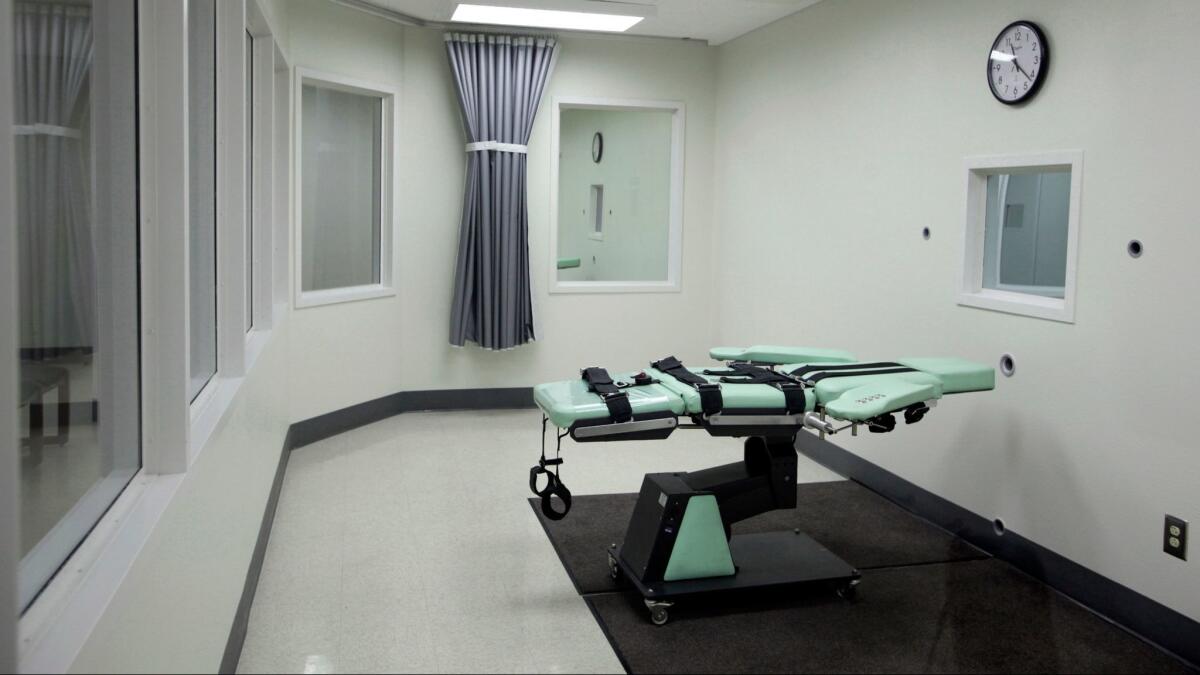Editorial: California’s Supreme Court thankfully refuses to put a deadline on death

The news that executions might resume in California after more than a decade is terribly depressing, for all the reasons we’ve repeated so often. Even those who don’t believe it is cruel and unusual for the state to take lives must see that death sentences are meted out unfairly and disproportionately to the poor and minorities. And mistakes can easily be made (consider that at least 159 inmates already on death row have been exonerated nationwide since 1973). And what’s more, the death penalty has been repeatedly shown to have no deterrent effect on crime, one of the key arguments proponents make in favor of it.
Despite all that, the people of California have repeatedly voted to keep it. And last year they went a step further, approving an initiative to speed up the notoriously slow appeals process so that condemned prisoners could be put to death more expeditiously. On Thursday, the state Supreme Court upheld the constitutionality of much — but not all — of that law.
Our view is this: If executions are going to happen (and they shouldn’t), the system must be rigorously careful and fair beyond questioning. That means making sure that due process rights are scrupulously enforced and that everyone facing a death sentence has a thorough chance to argue for innocence or mercy. Such steps can take a long time and can be frustrating to those, especially relatives and friends of murder victims, who would like to see sentences carried out. But even the condemned have constitutional rights that must be observed.
Executions could resume in California in a year or so for the 18 death row inmates who have already exhausted their appeals.
Proposition 66 was designed to speed up executions by setting a five-year limit on the state appeals process, expanding the pool of appellate attorneys to handle cases, allowing lower courts to hear certain appeals instead of just the Supreme Court, and allowing the state to approve a new lethal injection protocol without going through the usual lengthy process for adopting new regulations. On Thursday, the court noted that the proposition included no mechanism for enforcing its requirement that all state death appeals be completed in five years. Therefore, the court said, the timeline must be considered “directive rather than mandatory.” That’s a relief because it means the courts won’t cut corners — in the form of prisoners’ due process rights — to meet the proposition’s arbitrary deadlines.
The decision also leaves it unclear how much real impact the proposition will have on accelerating the appeals process and execution timetables — especially since expanding the capacity of the system hinges on additional funding from the state Legislature for more defense appellate lawyers and other related costs.
The most immediate effect of the ruling is that, barring further legal impediments — efforts to develop a new single-drug execution protocol, for instance, still must get approval by a federal judge under a separate legal challenge — executions could resume in California in a year or so for the 18 death row inmates who have already exhausted their appeals. They are only a fraction of the state’s 748 condemned killers. Which means California’s death penalty system, which has been more of an abstract concept for the last decade, could be on the verge of roaring back to life. In fact, since California resumed the death penalty in 1978, more than 900 people have been sentenced to death, but only 13 have actually been killed. Inmates have spent an average of more than 17 years on death row, and 108 have died of causes other than execution.
California’s death penalty has been dysfunctional for years, and should have been ended a long time ago. But when they passed Proposition 66, voters also rejected a separate proposition that would have banned capital punishment altogether. In doing so, they placed the state against the tide of progress on the issue. The U.S. is one of the few nations in the developed world that still executes convicted criminals, and the vast majority of executions in this country are carried out by only a handful of counties in a handful of states. Executions themselves have declined around the country from a peak of nearly 100 in 1999 to 20 last year, suggesting that the nation’s “evolving standards of decency” are moving on. The U.S. Supreme Court should take note of this shift and remove this medieval mechanism from the machinery of criminal justice.
Follow the Opinion section on Twitter @latimesopinion or Facebook
More to Read
A cure for the common opinion
Get thought-provoking perspectives with our weekly newsletter.
You may occasionally receive promotional content from the Los Angeles Times.










